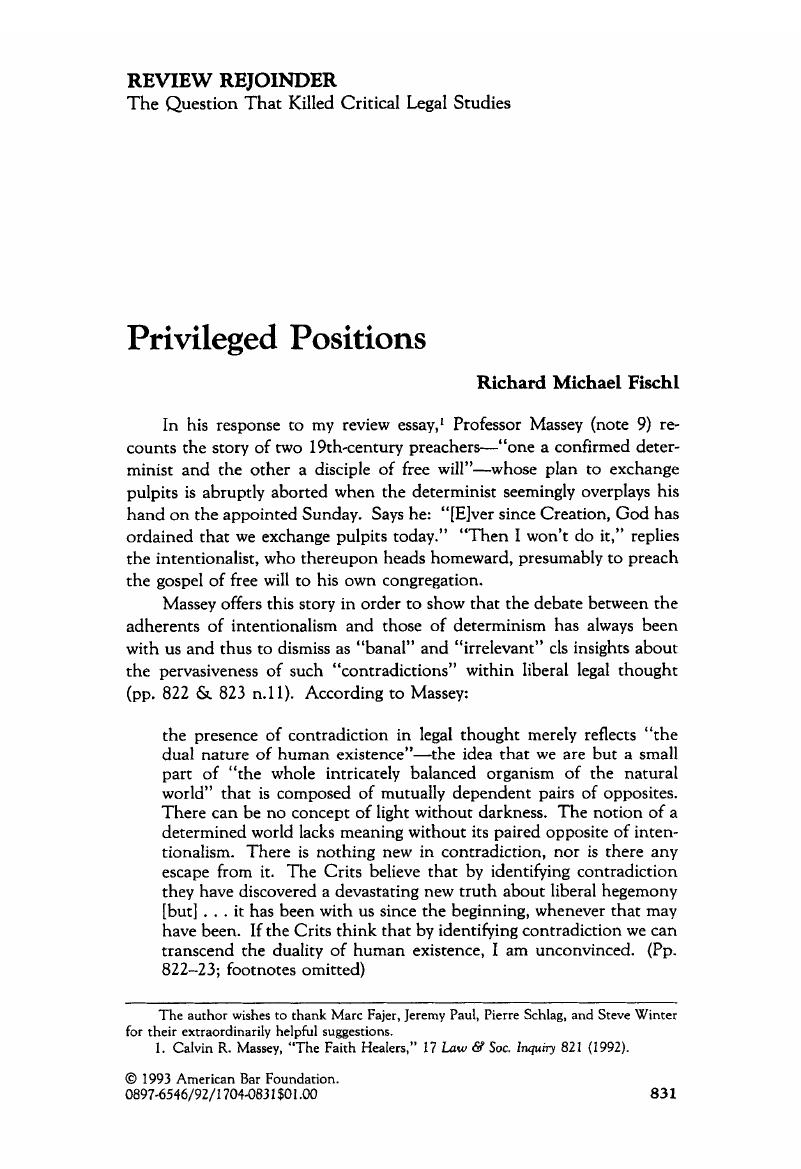No CrossRef data available.
Published online by Cambridge University Press: 27 December 2018

1 Massey, Calvin R., ‘The Faith Healers,” 17 Law & Soc. Inquiry 821 (1992).CrossRefGoogle Scholar
2 Consider just a few of the more salient aspects of human experience that Massey's “vision” would seem to ignore: caring, community, connection, dependence, empathy, family, love, need, obligation, reliance, responsibility. This is ironic, given Massey's suggestion elsewhere in his piece that liberalism's “talk of rights” ought perhaps to be recast in order to take into account “a social as well as an individual dimension” (p. 826)—an insight that he credits to Mary Ann Glendon but which sounds an awful lot like the critique of rights rhetoric that scholars associated with CIS were already making nearly a decade ago. See, e.g., Gabel, Peter, “The Phenomenology of Rights-Consciousness and the Pact of the Withdrawn Selves,” 62 Tex. L Rev. 1563 (1984); Horwitz, Morton J., “Rights,” 23 Harv. C.R.C.L. L Rev. 393 (1988); Duncan Kennedy, “Critical Labor Theory: A Comment,” 4 Indm. Rel. L.J. 503 (1981); Staughton Lynd, “Communal Rights,” 62 Tex. L Rev. 1417 (1984); Mark Tushnet, “An Essay on Rights,” 62 Tex. L Rev. 1363 (1984); see generally Robin West, “Jurisprudence and Gender,” 55 U. Chi. L Rev. 1 (1988) (comparing liberal, critical, and feminist views of rights discourse). But whatever its pedigree, this “social … dimension” all but disappears when Massey attempts to “profess” his “vision”—a phenomenon that seems to me to be attributable not so much to any failing on Massey's part but to the question that his “vision” is trying to answer. As I argued in my review essay—and as 1 shall re-emphasize in a moment—-What would you put in its place? is a question that by its very terms addresses the self directed autonomous subject; we should hardly be surprised, then, when the self-directed autonomous subject provides the reply.Google Scholar
3 For insightful elaborations of this point, see the work of Pierre Schlag (particularly “Contradiction and Denial,” 87 Rev, Mich L. 1216 (1989), and “Normativity and the Politics of Form,” 139 U. Pa. L. Rev. 801, 805, 907 (1991)) and of my colleague Steve Winter(particularly Foreword: “On Building Houses,” 69 Tex. L. Rev. 1595, 1597 (1991), and “For What It's Worth,” 26 Law & Soc. Rev. 879 (1992)).Google Scholar
4 Massey, Calvin R., “Law's Inferno,” 39 Hastings L.J. 1269, 1294 (1988) (book review).Google Scholar
5 Daniel Farber, “Down by Law,”New Republic, 4 Jan. 1988, at 36, 38.Google Scholar
6 Genovese, Eugene D., “Critical Legal Studies as Radical Politics and World View,” 3 Yale J.L. & Hum. 131, 144–45, 147 (1991) (book review).Google Scholar
7 Within the legitimate and necessary constraints of his social being, naturally.Google Scholar
For the record, the misreading of Kelman and cls continues unabated. Thus, Massey is simply wrong when he suggests that critical scholars subscribe to the “Western myth of progress—the idea that life involves an inexorable march toward human betterment”—and thus naively believe that the insights we might generate about liberal legal thought will necessarily lead to a better world (p. 625). In fact, Kelman spends the better part of a chapter describing the rejection of that myth by critical scholars (at 213-41), and accordingly the critical claim is far more modest: How can a responsible search for an “escape” from our current predicament even be contemplated without an honest and painstaking attempt at an examination of the predicament itself?Google Scholar
Similarly, compare Massey's reference to Roberto Unger's supposed “infatuation” with “the thoroughly brutal, vicious, and totalitarian politics and practices of the Red Guards of the Chinese Revolution” (note 13) with the decidely uninfatuated and antitotalitarian analyses of those “politics and practices” in Unger's False Necessity: Anti-Necessitarian Social Theory in the Service of Radical Democracy, part 1 of Politics: A Work in Constructive Social Theory (New York: Cambridge University Press, 1987), the work to which Massey evidently refers. Thus, Unger argues that the Cultural Revolution was a “failed attempt” to break out of the rigid institutional structures of the Soviet communist model (id. at 241—46); that the potentially revolutionary practices of “criticism and self-criticism” were ultimately deployed not to “escape from the consolidation of bureaucratic power” but as “a weapon of intimidation in an elite conflict” and “a subtle method for reasserting consensus and control,” so that the “fundamentals of power at every level would remain out of bounds to conflict and complaint” (id at 242–43); that these critical practices—-even in the hands of those who utilized them in an “attempt to chasten and, if possible, to destroy the established bureaucracies of party and state and to produce a new man or woman, new above all in their attitude toward authority”—were undermined by the “single-minded focus” on the struggle between elites and masses, so that the “crudest allocations of personal role, or the most rigid conceptions of the style of association suitable to each domain of social life, could be accepted so long as they did not Overtly involve the feared contrast between elite and mass” (id. at 568–70); and that the Cultural Revolution was in the end “a case of failure in breakthrough toward an alternative mode of socialism and industrialism, unless the breakthrough is defined as a return to a clearer version of preexisting institutions, a return permitting limited decentralizing experiments and achieved at the cost of a protracted ordeal of provoked, uncontrolled, and suppressed insurrection” (id. at 245).Google Scholar
8 Schlag, 139 U. Pa. L. Rev. at 805.Google Scholar
9 Or the Red Guards, for that matter; see supra note 7.Google Scholar
10 I have. See “The Question That Killed Critical Legal Studies,” 17 Law & Soc. Iquiry 779, 802–3 (1992).CrossRefGoogle Scholar